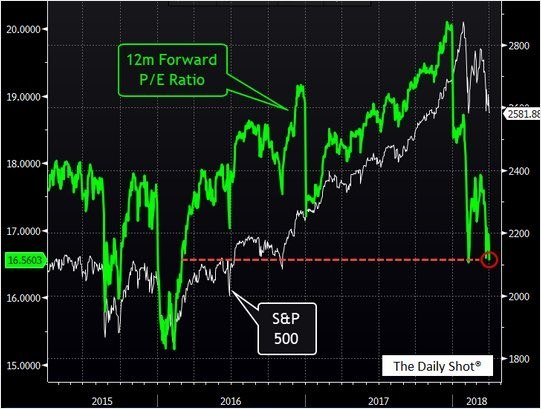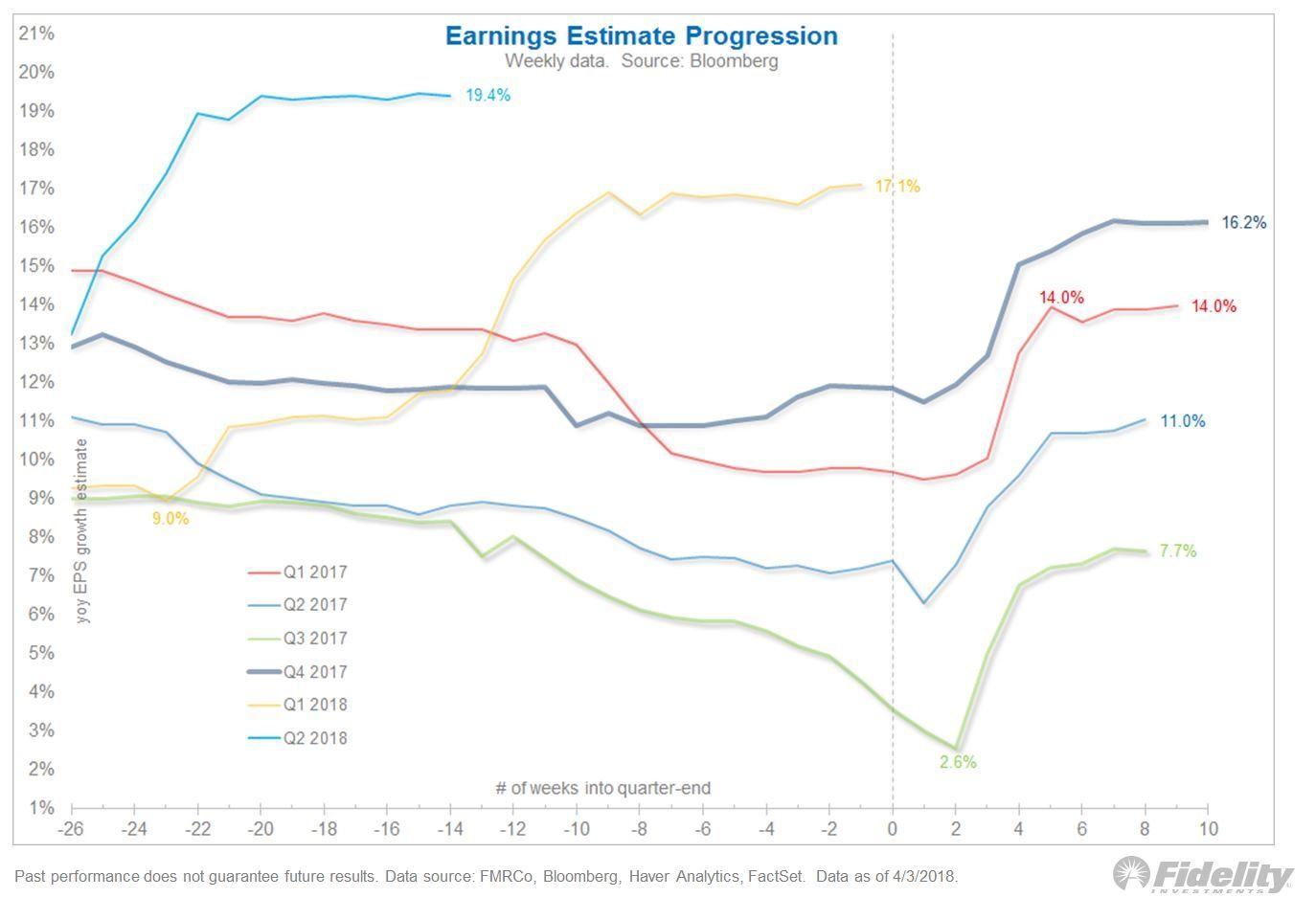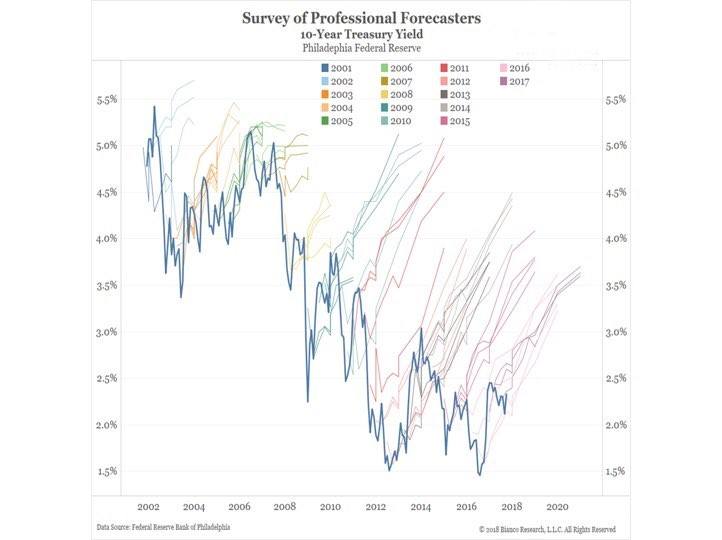Stocks Rally On Tuesday
The S&P 500 was up 1.26% on Tuesday. The VIX was down 10.67% to 21.10 which is still relatively high. Every sector was up. The best ones were energy and healthcare which increased 2.14% and 1.52% respectively. Some traders have expressed hope that another sector such as the financials will take the leadership from the tech sector which has languished in the past few days. Tech was only up 1.01% which is surprisingly weak for a ‘risk on’ day. Some traders say they would rather see the market go up in small increments over time instead of a big spike up because spikes signal short covering. I’m not a short term trader so I can’t specify which type of move I’d prefer.
PE Multiple Compression
My main focus is the understanding that double digit earnings growth and a weak, but non-recessionary, economy aren’t consistent with a bear market. The chart below shows the 12 month forward PE ratio has fallen to 16.56 which is the lowest since early 2016. In 2016, I was bearish on stocks because they were increasing as earnings growth was negative. Now we’re seeing stocks fall on great earnings. Stocks like to price in future economic trends. In late 2016, it became clear the economy was starting to rebound. Now it looks like the economy is weakening. The key difference is firms have the benefit of tax cuts and a repatriation holiday. I don’t think it’s fair to completely ignore the great earnings results which is why I am confident in my projection that there won’t be a bear market.

1H 2018 Earnings Look Strong
The chart below shows the earnings estimate progressions for the past few quarters and the future ones. As you can see, the estimates last year generally fell before the reporting period and increased afterwards. This is the normal lowering of the bar so that the results can beat estimates. You can see the growth has been improving since Q4. This quarter hasn’t seen the normal decline in estimates. Obviously, the tax cuts provided a boost in January, but it’s still impressive that there haven’t been negative revisions. Q2 has also had steady estimates in the past few weeks. We’ll see how the results come in to determine how good this pre-earnings period was. If the results beat less than average, we’ll know the bar was raised too high. If they beat more than average, I think the market will have a swift exit from this correction and probably make new record highs.

Bonds Sell Off
On Tuesday bonds sold off which makes sense because this was a ‘risk on’ day. The 10 year yield was up about 5.5 basis points to 2.77% and the 2 year yield was up about 5 basis points to 2.27%. The difference between them is now about 50 basis points as there has been some slight steepening in the curve. The chart below is interesting because it claims that if the 3 standard deviation economic optimism becomes a 3 standard deviation level of pessimism, the yield curve will invert in September. I don’t agree with the premise that there will be such pessimism, but it’s worth considering that time frame as the earliest possible point an inversion can occur. The base case scenario in this chart implies an inversion in January 2019.

The chart below shows the track record of professionals trying to predict where the 10 year bond yield will go. As you can see, they have always expected a major spike in yields. It has been a contrarian bet to stay long the 10 year treasury bond even though this is a multi-decade long bull market. GDP growth per capita and inflation have slowed as the populations in the developed world have aged. My long call on the 10 year bond when it was yielding 2.95% was made because hedge funds were too short and because I expected growth and inflation to slow in the next couple months. It could get above 3% if growth accelerates and there finally is wage growth acceleration because of a full labor market.

The Negative History Of Forward Earnings Estimates
.The chart below shows the actual earnings compared to the 12 month forward earnings estimates pushed back a year. As you can see, the results rarely meet expectations. They are most likely to meet or beat estimates when the economy is coming out of a recession. The estimates made for Q1 2018 will be beaten by far because of the tax cuts. The current period hasn’t seen many positive earnings pre-announcement. The question on investors’ minds is whether this is because the positivity is baked in the estimates or because this won’t be that great of a earnings period. While the economy has weakened modestly in Q1, I still expect decent results.

Leading Indicators Signal To Buy The Dip
Besides the strong earnings season, the leading indicators are also signaling that you should buy this correction. As you can see from the chart below, the leading indicators were falling as the stock market began its decent in 2000 and 2008. The leading indicators actually include the stock market, so it’s a testament of strength to see them doing well even as stocks have fallen in the past few weeks. Some say the stock market crashing could cause weakness in the economy as a reflexivity event. I think it certainly wouldn’t inspire confidence to see stocks fall 30%, but it probably wouldn’t cause a recession. The recent volatility in stocks appears to have impacted consumer confidence only slightly. I’ll be watching for more weakness if stocks fall further, but I don’t expect stocks to decline much more.

Conclusion
Stocks certainly aren’t cheap on a forward earnings basis, but they are reasonably valued. The strength in the leading indicators along with the strong earnings estimates should prevent a bear market. Furthermore, it’s possible if earnings beat estimates in the next few weeks when firms start reporting, it can be a catalyst to upside in the market. Stocks will climb the wall of worry that seems to exist in the headlines as traders worry about tariffs and the catalysts causing individual tech firms to correct.
Don Kaufman: Trade small and Live to trade another day at Theotrade.
Neither TheoTrade or any of its officers, directors, employees, other personnel, representatives, agents or independent contractors is, in such capacities, a licensed financial adviser, registered investment adviser, registered broker-dealer or FINRA|SIPC|NFA-member firm. TheoTrade does not provide investment or financial advice or make investment recommendations. TheoTrade is not in the business of transacting trades, nor does TheoTrade agree to direct your brokerage accounts or give trading advice tailored to your particular situation. Nothing contained in our content constitutes a solicitation, recommendation, promotion, or endorsement of any particular security, other investment product, transaction or investment.
Trading Futures, Options on Futures, and retail off-exchange foreign currency transactions involves substantial risk of loss and is not suitable for all investors. You should carefully consider whether trading is suitable for you in light of your circumstances, knowledge, and financial resources. You may lose all or more of your initial investment. Opinions, market data, and recommendations are subject to change at any time. Past Performance is not necessarily indicative of future results
Recommended Content
Editors’ Picks
EUR/USD edges lower toward 1.0700 post-US PCE

EUR/USD stays under modest bearish pressure but manages to hold above 1.0700 in the American session on Friday. The US Dollar (USD) gathers strength against its rivals after the stronger-than-forecast PCE inflation data, not allowing the pair to gain traction.
GBP/USD retreats to 1.2500 on renewed USD strength

GBP/USD lost its traction and turned negative on the day near 1.2500. Following the stronger-than-expected PCE inflation readings from the US, the USD stays resilient and makes it difficult for the pair to gather recovery momentum.
Gold struggles to hold above $2,350 following US inflation

Gold turned south and declined toward $2,340, erasing a large portion of its daily gains, as the USD benefited from PCE inflation data. The benchmark 10-year US yield, however, stays in negative territory and helps XAU/USD limit its losses.
Bitcoin Weekly Forecast: BTC’s next breakout could propel it to $80,000 Premium

Bitcoin’s recent price consolidation could be nearing its end as technical indicators and on-chain metrics suggest a potential upward breakout. However, this move would not be straightforward and could punish impatient investors.
Week ahead – Hawkish risk as Fed and NFP on tap, Eurozone data eyed too

Fed meets on Wednesday as US inflation stays elevated. Will Friday’s jobs report bring relief or more angst for the markets? Eurozone flash GDP and CPI numbers in focus for the Euro.